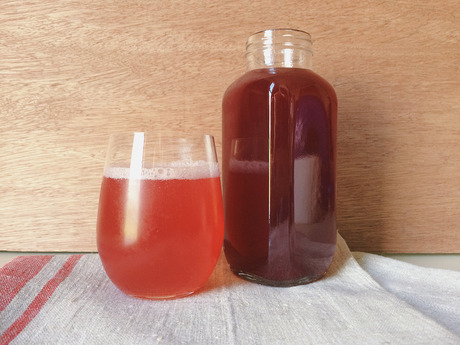Disclosures: Austin Honey Company proivided me with honey at no cost. The links to the books mentioned below offer a pittance to my Amazon affiliate account if purchased via those links, which, when added up, helps me continue to create recipes and projects for this blog.
 Shrubs are a great destination for less than glamorous fruit. This delicious syrup is refined sugar free and great for cooling off after work, indoors or out. Add some bourbon or brandy and call it happy hour.
Shrubs are a great destination for less than glamorous fruit. This delicious syrup is refined sugar free and great for cooling off after work, indoors or out. Add some bourbon or brandy and call it happy hour.
Farmshare Austin grew these gorgeous plums in Cedar Creek, TX and gifted them to me after an event a couple weeks ago. I let them sit in the refrigerator a little longer than I should have. Some of the ripest plums softened considerably, which meant they were a prime candidate for shrub’ing! (Yeah, I verbed that.) The other, still perfect plums became a chutney using Sherri Brooks Vinton’s recipe from her book Put ‘Em Up.
This shrub syrup recipe is based on my any fruit shrub methodology in the kitchen book; an excerpt of that section is included below. I cut it in half based on the amount of inglorious plums I had to work with. Instead of a sugar simple syrup I made a honey simple syrup using honey from Austin Honey Company. I know most of you are not in Austin, but the point is you should love your honey since it’s one of two flavors in this delicious little potion. The farmers’ market is a great place to shop for honey since you can usually taste it before you buy it and the honey vendor can tell you about the bees who made this treat and what flowers they were pollinating, which contributes to flavor notes.
Plum and Honey Shrub syrup
ingredients:
1 cup soft or overripe plums
1 cup white vinegar
1/2 cup honey dissolved in 1/2 cup warm water
method:
Follow method indicated below, but make a honey simple syrup instead of the sugar syrup. Making a honey simple syrup uses the same ratio as the sugar syrup, 1:1 honey to water and you can just start with warm water to dissolve the honey and avoid heating the honey directly, keeping it raw (if the water was below 110 degrees F) if that’s one of your health benefit goals.




